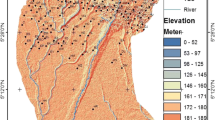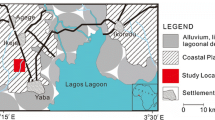Abstract
Aquifer characterization is essential for groundwater sustainability in the Niger Delta region. The unconsolidated aquifers of the region are sandy and porous, and have the potential to allow the passage of contaminants to the groundwater resource. The first-order geo-electric parameters of the subsurface, procured by injection of a direct current into the ground were applied to evaluate the aquifer vulnerability in the region. The Schlumberger architecture was engaged to acquire vertical electrical sounding (VES) data at different points and processed using Interpex 1D™. Electrical resistivity imaging (ERI) using a multi-electrode Wenner-α array was also applied across the study area and constrained with existing borehole data to establish the accuracy of the VES results. The VES result revealed the occurrence of 5 to 6 geo-electric strata across the region. The rock types identified from the VES result and ERI pseudo-section were mostly sandstone intercalated with shale and clayey sand at some points. The result also revealed that the depth to water-bearing formation within the area is relatively shallow with aquifer depth values ranging from 7.7 to 103 m and thickness of the aquifer varies from 4.7 to 149.7 m, while the aquifer resistivity values ranged from 470.84 to 2697.7 Ωm. The aquifer protective coverage (APC) assessment revealed that the study area has weak and poor protective covers, while the geo-electric layer susceptibility indexing (GLSI) shows that the area is characterized by low and moderate vulnerability status. The GOD index measurement across the area also revealed that the area has low and average vulnerability status at different points. GOD represents an acronym for three hydrogeological factors, and they are confinement of the aquifer (G), overlying lithology of the aquifer (O), and depth to the aquifer (D). The poor and weak protective covers which gave rise to the low and average vulnerability are indicators that the aquifers within the region are prone to contamination from surface sources. This research is vital for groundwater management and contamination assessment in sandy aquifers.










Similar content being viewed by others
References
Abam T, Nwankwoala H (2020) Hydrogeology of Eastern Niger Delta: a review. J Water Resource Prot 12:741–777. https://doi.org/10.4236/jwarp.2020.129045
Akinwumiju AS, Orimoogunje OOI (2013) Predicting the yields of deep wells of the deltaic formation, Niger Delta Nigeria. Hydrol Curr Res 4:1. https://doi.org/10.4172/2157-7587.1000145
Akpoborie IA (2011) Groundwater conditions in the mangrove swamps of the western Niger Delta: case study of Ughoton area, Delta State, Nigeria. J Environ Hydrol 20:1–14
Allen JRL (1965) Late quaternary Niger Delta and adjacent areas: sedimentary environments and lithofacies. Bull Am Petroleum Geol 49:547–600
Anejionu O, Blackburn A, Whyatt D (2012) Improving remote survey of gas flaring in the Niger Delta region of Nigeria with Landsat imagery. Proceedings of the GIS Research UK (GISRUK) 20th Annual Conference
Asseez OL (1989) Review of the Stratigraphy, Sedimentation and Structure of the Niger Delta. In: Kogbe CA (ed) Geology of Nigeria, Rock View (Nig.) Ltd., pp 311–324
Aweto KE (2012) Hydrogeological deductions from geoelectric and downhole geophysical data in Okpara Inland, western Niger Delta Nigeria. Middle East J Sci Res 11(1):100–105
Aweto KE, Ohwoghere-Asuma O, Omeru T (2023) A comparative aquifer vulnerability study of the Quaternary Sombreiro – Warri Deltaic Plain deposits, western Niger Delta, Nigeria. Ife J Sci 25(1). https://doi.org/10.4314/ijs.v25i1.8
Baird J (2010) “Oil’s Shame in Africa,” Newsweek 156(4):27–27
Binley A, Hubbard SS, Huisman JA, Revil A, Robinson DA, Singha K, Slater LD (2015) The emergence of hydrogeophysics for improved understanding of subsurface processes over multiple scales. Water Resour Res 51(6):3837–3866. https://doi.org/10.1002/2015WR017016
Braga ACO, Dourado JC, Malagutti Filho W (2006) Resistivity (DC) method applied to aquifer protection studies. Braz J Geophysics 24(4):573–581
Carey AM, Paige GB, Carr BJ, Holbrook WS, Miller SN (2019) Characterizing hydrological processes in a semiarid rangeland watershed: a hydrogeophysical approach. Hydrol Process 33(5):759–774. https://doi.org/10.1002/hyp.13361
Delta State Hospital Management Board (2014) Health status of rural communities in Delta State, Health Report, vol 6. Ministry of Health, Asaba, p 12
Deming B D (2003) Introduction to Hydrogeology, 1st edition. Hydrogeol J 11:413–414. https://doi.org/10.1007/s10040-002-0217-5
Doetsch J, Linde N, Pessognelli M, Green AG, Günther T (2012) Constraining 3-D electrical resistance tomography with GPR reflection data for improved aquifer characterization. J Appl Geophy 78:68–76. https://doi.org/10.1016/j.jappgeo.2011.04.008
Efobo O, Ugbe FC, Akpoborie IA (2020) Groundwater conditions and hydrogeochemistry of the Sombreiro-Warri Deltaic Plain deposit (Shallow Benin Formation) in the Vicinity of Agbarho, Nigeria. J Sci Res 12(4):633–643. https://doi.org/10.3329/jsr.v12i4.45187
Egbai JC (2011) Vertical electrical sounding for the determination of aquifer transmisivity. Aust J Basic Appl Sci 5:1207–1214
Emeh C, Igwe O (2018) Effect of environmental pollution on susceptibility of sesquioxide-rich soils to water erosion. Geol Ecol Landsc 2(2):115–126
Emeshili ME (2008) Quality assessment of the potability of borehole and surface waters in the Ndokwa area of Delta State, Nigeria. Unpublished Dissertation, Delta State University, Abraka, Nigeria, p 254
Etu-Efeotor JO, Akpokodje EG (1990) Aquifer systems of the Niger Delta. J Min Geol 26(2):279–285
Fabiyi OO, Yesuf GU (2013) Dynamics and characterization of coastal flooding in Nigeria: implication for local community management strategies. Ife Res Publications in Geogr 12(1-2):45–61
Ferreira SJF, Pinel S, Rios-Villamizer EA, Miranda SAF, Pascoaloto D, Vital ART, Monteiro MTF, Rocha da Silva MS, Brandao da Cunha TR, Salgado dos Santos A, Bender S, Brando da Cunha H (2021) Impact of rapid urbanization on stream water quality in the Brazilian Amazon. Environ Earth Sci 80:316
Gemail KS, Alfy EM, Ghoneim MF, Shishtawy AM, El-Bary MA (2017) Comparison of DRASTIC and DC resistivity modeling for assessing aquifer vulnerability in the central Nile Delta, Egypt. Environ Earth Sci 76(9):1–17
Golam SS, Keramat M, Shahid M (2016) Deciphering transmissivity and hydraulic conductivity of the aquifer by vertical electrical sounding (VES) experiments in Northwest Bangladesh. Appl Water Sci 6:35 to 45
Irumhe EP, Osaghae SO, Obiadi II, Obiadi CM, Mgbolu CC (2022) Vulnerability studies of aquifer potential within Auchi Polytechnic Campuses. Arab J Geosci 15:1537. https://doi.org/10.1007/s12517-022-10824-w
Kalinski RJ, Kelly W, Bogardi I, Ehrman R (1994) Correlation between DRASTIC vulnerabilities and incidents of VOC contamination of municipal wells in Nebraska. Groundwater 32:31–34
Khemiri S, Khnissi A, Alaya BA, Saidi S, Zargrouni F (2013) Using GIS for the comparison of intrinsic parameter methods assessment of groundwater vulnerability to pollution in scenarios of semi-arid climate. The case of foussana groundwater in the central of Tunisia. J Water Resource Prot 5(8). https://doi.org/10.4236/jwarp.2013.58084
Kuenzer C, van Beijma S, Gessner U, Dech S (2014) Land surface dynamics and environmental challenges of the Niger Delta, Africa: remote sensing-based analyses spanning three decades (1986–2013). Appl Geogr 53:354–368
Lashkarripour GR (2003) An investigation of groundwater condition by geoelectrical resistivity method: a case study in Korin aquifer, Southeastern Iran. J Spat Hydrol 3:1–5
MacDonald AM, Lark RM, Taylor RG, Abiye T, Fallas HC, Favreau G, Goni IB, Kebede S, Scanlon B, Sorensen JPR (2021) Mapping groundwater recharge in Africa from ground observations and implications for water security. Environ Res Lett 16(3):034012. https://doi.org/10.1088/1748-9326/abd661
Matemilola S, Adedeji OH, Elegbede I, Kies F (2019) Mainstreaming climate change into the EIA process in Nigeria: perspectives from Projects in the Niger Delta Region. Climate 7(2):29. https://doi.org/10.3390/cli7020029
Mawer C, Parsekian A, Pidlisecky A, Knight R (2016) Characterizing heterogeneity in infiltration rates during managed aquifer recharge. Groundwater 54(6):818–829. https://doi.org/10.1111/gwat.12423
Mgbolu CC, Obiadi II, Obiadi CM, Okolo CM, Irumhe PE (2019) Integrated groundwater potentials studies, aquifer hydraulic characterization vulnerability investigations of parts of Ndokwa, Niger Delta Basin, Nigeria. J Solid Earth Sci 4:102–112. https://doi.org/10.1016/j.sesci.2019.06.002
Nyakno JG (2021) Geo-electrically and hydrogeologically derived vulnerability assessments of aquifer resources in the hinterland of parts of Akwa Ibom State, Nigeria. Solid Earth Sci 6(2):70–77
Obiadi II, Ajaegwu NE, Meniru CI, Nzeakor IC, Ejike RC (2022) Aquifer potentials and vulnerability studies in Northern parts of Anambra State, SE Nigeria. Sustain Water Resour Manag 8(6). https://doi.org/10.1007/s40899-022-00768-0
Ogungbemi OS, Badmus GO, Ayeni OG, Ologe O (2013) Geo- electric investigation of aquifer vulnerability within Afe Babalola University, Ado–Ekiti, Southwestern Nigeria. J Appl Geol Geophys 1:28–34
Ojeh VN, Origho T, John PH (2012) Agriculture as an index of socio-economic development of Delta State of Nigeria. World Environ 2(4):62–68. https://doi.org/10.5923/j.env.20120204.02
Oladapo MI, Mohammed MZ, Adeoye OO, Adetola OO (2004) Geo-electric investigation of the Ondo-State Housing Corporation Estate Ijapo, Akure southwestern Nigeria. J Mining Geol 40:41–48
Oni TE, Omosuyi GO, Akinlalu AA (2017) Groundwater vulnerability assessment using hydro-geologic and geo-electric layer susceptibility indexing at Igbara Oke, Southwestern Nigeria. NRIAG J Astron Geophys 6:452–458
Oseji JO (2010) Geo-electric investigation of groundwater resources and aquifer characteristics in Utagba-Ogbe Kingdom Ndokwa Land Delta State Nigeria. J Env Chemistry and Ecotoxicology 2:38–46
Pedreira R, Kallioras A, Pilakas F, Gkiougkis I, Schuth C (2015) Groundwater vulnerability assessment of a coastal aquifer system at River Nestos eastern Delta, Greece. Environ Earth Sci 73(10):6387–6415
Plummer R, De Leo R, Armitage D (2012) A systematic review of water vulnerability assessment tools. Water Resour Manag 26:4327–4346
Rao SM, Sekhar M, Rao PR (2013) Impact of pit-toilet leachate on groundwater chemistry and role of vadose zone in removal of nitrate and E. coli pollutants in Kolar district, Karnataka, India. Environ Earth Sci 68(4):927–938
Reijers TAJ (2011) Stratigraphy and sedimentology of the Niger Delta. Geologos 17(3):133–162
Seifollahi-Aghmiuni S, Kalantari Z, Egidi G, Gaburova L, Salvati L (2002) Urbanization-driven land degradation and socioeconomic challenges in peri-urban areas: insight from Southern Europe. Ambio. https://doi.org/10.1007/s13280-022-01701-7
Sexton WJ, Murday M (1994) The morphology and sediment character of the coastline of Nigeria-the Niger delta. J Coast Res 10(4):959–977
Odunuga S, Raji SA (2018) Geomorphological mapping of part of the Niger Delta, Nigeria using DEM and multispectral imagery. Journal of Natural Sciences. Eng Technol 17(1-2):121–146. https://doi.org/10.51406/jnset.v17i1.1904
Ugboma PP (2014) Effects of oil spillage on soil fertility in Udu local government area in Delta state. AFRREV STECH: An International. J Sci Technol 3(3). https://doi.org/10.4314/stech.v3i3.5
Uhlemann S, Kuras O, Richards LA, Naden E, Polya DA (2017) Electrical resistivity tomography determines the spatial distribution of clay layer thickness and aquifer vulnerability, Kandal Province, Cambodia. J Asian Earth Sci 147:402–414. https://doi.org/10.1016/j.jseaes.2017.07.043
Umar ND, Igwe O (2019) Geo-electric method applied to groundwater protection of a granular sandstone aquifer. Appl Water Sci 9:112
Wagner FM, Uhlemann S (2021) An overview of multimethod imaging approaches in environmental geophysics. Adv Geophys 62, Chap. 1:1–72. https://doi.org/10.1016/bs.agph.2021.06.001
Acknowledgements
The authors are grateful to the management of EssBee GTVL Enugu, Nigeria, for providing the equipment used for resistivity measurement. They also appreciate the assistance of Mr. Patrick Okenwa in the fieldwork.
Author information
Authors and Affiliations
Corresponding author
Ethics declarations
Conflict of interest
The authors declare that they have no competing interests.
Additional information
Responsible Editor: Broder J. Merkel
Rights and permissions
Springer Nature or its licensor (e.g. a society or other partner) holds exclusive rights to this article under a publishing agreement with the author(s) or other rightsholder(s); author self-archiving of the accepted manuscript version of this article is solely governed by the terms of such publishing agreement and applicable law.
About this article
Cite this article
Mgbolu, C.C., Obiadi, I.I., Opuh, C.K. et al. Characterization of aquifer vulnerability in parts of the western Niger Delta. Arab J Geosci 17, 66 (2024). https://doi.org/10.1007/s12517-024-11867-x
Received:
Accepted:
Published:
DOI: https://doi.org/10.1007/s12517-024-11867-x




